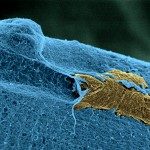Link to Pubmed [PMID] – 18098349
J. Pathol. 2008 Mar;214(4):434-44
Chronic granulomatous disease (CGD), a genetic disorder characterized by the absence of a functional phagocyte NADPH oxidase, is a severe immune deficiency. However, non-infectious hyperinflammation is a second hallmark of the disease. In CGD mouse models, sterile hyperinflammation can be induced by A. fumigatus cell wall preparations. In this study, we used subcutaneous injection of microbial cell walls and cell wall components to identify causes of CGD hyperinflammation and to characterize its histological features. Sterile cell wall preparations from fungi (A. fumigatus, C. albicans, S. cerevisiae), but not from bacteria (S. aureus, P. aeruginosa, E. coli), caused prolonged and severe skin inflammation in CGD mice. To identify fungal cell wall elements responsible for this process, we investigated microbial cell wall-derived monosubstances. Injection of beta(1-3)(1-6)-glucan induced severe hyperinflammation in CGD mice, while other fungal cell components [mannan, (1-3) beta-glucan] or bacterial cell wall components (lipopolysaccharide, lipoteichoic acid) caused no or only moderate inflammation. beta-glucan-induced hyperinflammation was predominantly due to a defect in termination of inflammation, as in the initial stage (2 days), the severity of inflammation and the extent of cell death were comparable in wild-type and CGD mice. At later stages (7 days), beta(1-3)(1-6)-glucan-induced inflammation had subsided in wild-type mice. In contrast, CGD mice showed persistent severe inflammation with central necrosis, containing abundant apoptotic and necrotic cells. In summary, branched fungal beta-glucan induces a severe inflammatory reaction in the absence of phagocyte NADPH oxidase. As opposed to the commonly perceived notion that reactive oxygen species are the cause of cell death, our results demonstrate that tissue necrosis can be caused by the absence of a superoxide-producing enzyme.

